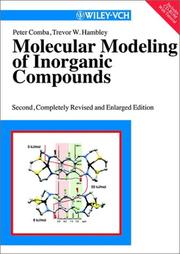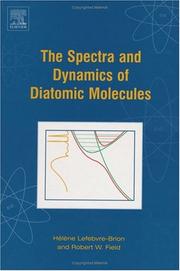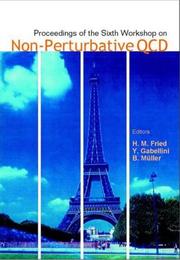| Listing 1 - 10 of 55 | << page >> |
Sort by
|

ISBN: 1614992150 9781614992158 9051992939 9789051992939 4274901297 9784274901294 Year: 1996 Publisher: Amsterdam Washington, DC
Abstract | Keywords | Export | Availability | Bookmark
 Loading...
Loading...Choose an application
- Reference Manager
- EndNote
- RefWorks (Direct export to RefWorks)
Book
Year: 1967 Publisher: New York (N.Y.) : Interscience,
Abstract | Keywords | Export | Availability | Bookmark
 Loading...
Loading...Choose an application
- Reference Manager
- EndNote
- RefWorks (Direct export to RefWorks)

ISBN: 3527299157 Year: 2001 Publisher: Weinheim : Wiley-VCH,
Abstract | Keywords | Export | Availability | Bookmark
 Loading...
Loading...Choose an application
- Reference Manager
- EndNote
- RefWorks (Direct export to RefWorks)
Inorganic compounds. --- Coordination compounds --- Molecular mechanics --- Molecular modeling --- Quantum mechanical methods
Book
ISBN: 0852745362 Year: 1983 Publisher: Bristol Hilger
Abstract | Keywords | Export | Availability | Bookmark
 Loading...
Loading...Choose an application
- Reference Manager
- EndNote
- RefWorks (Direct export to RefWorks)
Lasers --- Masers --- 535.374 --- 621.375.8 --- 621.375.8 Quantum-mechanical amplifiers --- Quantum-mechanical amplifiers --- 535.374 Amplification of radiation by stimulated emission --- Amplification of radiation by stimulated emission --- Light amplification by stimulated emission of radiation --- Masers, Optical --- Optical masers --- Light amplifiers --- Light sources --- Optoelectronic devices --- Nonlinear optics --- Optical parametric oscillators --- Microwave amplification by stimulated emission of radiation --- Quantum mechanical amplifiers --- Electromagnetism --- Electron tubes --- Infrared sources --- Microwave amplifiers --- Microwave devices --- Optical pumping --- Quantum electronics --- History --- Optics. Quantum optics

ISBN: 0124414559 0124414567 9786611119171 1281119172 0080517501 9780124414556 9780080517506 9780124414563 Year: 2004 Publisher: Amsterdam ; Boston : Elsevier Academic Press,
Abstract | Keywords | Export | Availability | Bookmark
 Loading...
Loading...Choose an application
- Reference Manager
- EndNote
- RefWorks (Direct export to RefWorks)
This book is written for graduate students just beginning research, for theorists curious about what experimentalists actually can and do measure, and for experimentalists bewildered by theory. It is a guide for potential users of spectroscopic data, and uses language and concepts that bridge the frequency-and time-domain spectroscopic communities. Key topics, concepts, and techniques include: the assignment of simple spectra, basic experimental techniques, definition of Born-Oppenheimer and angular momentum basis sets and the associated spectroscopic energy level patterns (Hund's

ISBN: 1281929964 9786611929961 9812778357 9789812778352 9810247486 9789810247485 0817631275 9780817631277 9781281929969 Year: 2002 Volume: 8 Publisher: River Edge, NJ World Scientific
Abstract | Keywords | Export | Availability | Bookmark
 Loading...
Loading...Choose an application
- Reference Manager
- EndNote
- RefWorks (Direct export to RefWorks)
This volume is devoted to different facets of QCD, stressing non-perturbative, analytic and lattice formulations, scattering solutions and approximations, and the understanding of recent RHIC experiments. It discusses ideas of the fifth dimension, originating in brane theory, as well as possible experimental tests and predictions of those ideas.
Book
ISBN: 9814525022 9789814525022 9789814525008 Year: 2014 Publisher: Singapore
Abstract | Keywords | Export | Availability | Bookmark
 Loading...
Loading...Choose an application
- Reference Manager
- EndNote
- RefWorks (Direct export to RefWorks)
In this revised and expanded edition, in addition to a comprehensible introduction to the theoretical foundations of quantum tunneling based on different methods of formulating and solving tunneling problems, different semiclassical approximations for multidimensional systems are presented. Particular attention is given to the tunneling of composite systems, with examples taken from molecular tunneling and also from nuclear reactions. The interesting and puzzling features of tunneling times are given extensive coverage, and the possibility of measurement of these times with quantum clocks are
Tunneling (Physics) --- Quantum theory. --- Quantum dynamics --- Quantum mechanics --- Quantum physics --- Physics --- Mechanics --- Thermodynamics --- Penetration probability --- Quantum mechanical tunneling --- Tunnel effect --- Electric conductivity --- Solids
Book
Year: 1963 Publisher: Cambridge : Cambridge university press,
Abstract | Keywords | Export | Availability | Bookmark
 Loading...
Loading...Choose an application
- Reference Manager
- EndNote
- RefWorks (Direct export to RefWorks)
Angular momentum. --- Central-field. --- Complex spectra. --- Configuration. --- Nucleus. --- Quantum mechanical method. --- Quantum theory. --- Radiation. --- Russell-Saunders case. --- Spectrum analysis. --- Stark effect. --- X-rays. --- Zeeman effect.
Book
Year: 1964 Publisher: Cambridge : Cambridge university press,
Abstract | Keywords | Export | Availability | Bookmark
 Loading...
Loading...Choose an application
- Reference Manager
- EndNote
- RefWorks (Direct export to RefWorks)
Angular momentum. --- Central-field. --- Complex spectra. --- Configuration. --- Nucleus. --- Quantum mechanical method. --- Quantum theory. --- Radiation. --- Russell-Saunders case. --- Spectrum analysis. --- Stark effect. --- X-rays. --- Zeeman effect.
Book
Abstract | Keywords | Export | Availability | Bookmark
 Loading...
Loading...Choose an application
- Reference Manager
- EndNote
- RefWorks (Direct export to RefWorks)
The QM/MM method, short for quantum mechanical/molecular mechanical, is a highly versatile approach for the study of chemical phenomena, combining the accuracy of quantum chemistry to describe the region of interest with the efficiency of molecular mechanical potentials to represent the remaining part of the system. Originally conceived in the 1970s by the influential work of the the Nobel laureates Martin Karplus, Michael Levitt and Arieh Warshel, QM/MM techniques have evolved into one of the most accurate and general approaches to investigate the properties of chemical systems via computational methods. Whereas the first applications have been focused on studies of organic and biomolecular systems, a large variety of QM/MM implementations have been developed over the last decades, extending the range of applicability to address research questions relevant for both solution and solid-state chemistry as well. Despite approaching their 50th anniversary in 2022, the formulation of improved QM/MM methods is still an active field of research, with the aim to (i) extend the applicability to address an even broader range of research questions in chemistry and related disciplines, and (ii) further push the accuracy achieved in the QM/MM description beyond that of established formulations. While being a highly successful approach on its own, the combination of the QM/MM strategy with other established theoretical techniques greatly extends the capabilities of the computational approaches. For instance the integration of a suitable QM/MM technique into the highly successful Monte-Carlo and molecular dynamics simulation protocols enables the description of the chemical systems on the basis of an ensemble that is in part constructed on a quantum-mechanical basis. This eBook presents the contributions of a recent Research Topic published in Frontiers in Chemistry, that highlight novel approaches as well as advanced applications of QM/MM method to a broad variety of targets. In total 2 review articles and 10 original research contributions from 48 authors are presented, covering 12 different countries on four continents. The range of research questions addressed by the individual contributions provide a lucid overview on the versatility of the QM/MM method, and demonstrate the general applicability and accuracy that can be achieved for different problems in chemical sciences. Together with the development of improved algorithms to enhance the capabilities of quantum chemical methods and the continuous advancement in the capacities of computational resources, it can be expected that the impact of QM/MM methods in chemical sciences will be further increased already in the near future.
Quantum Chemistry --- Hybrid Quantum Mechanical/Molecular Mechanical --- Density Functional Theory --- Ab initio/First Principles --- QM/MM --- Empirical Potentials --- Molecular Mechanics --- Force Field
| Listing 1 - 10 of 55 | << page >> |
Sort by
|

 Search
Search Feedback
Feedback About UniCat
About UniCat  Help
Help News
News